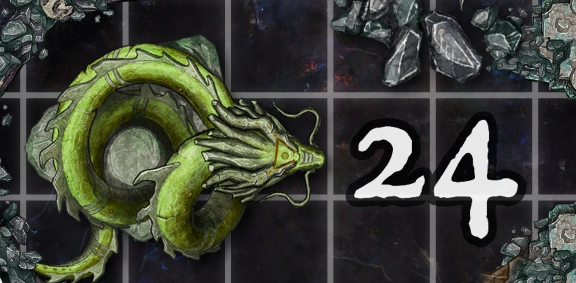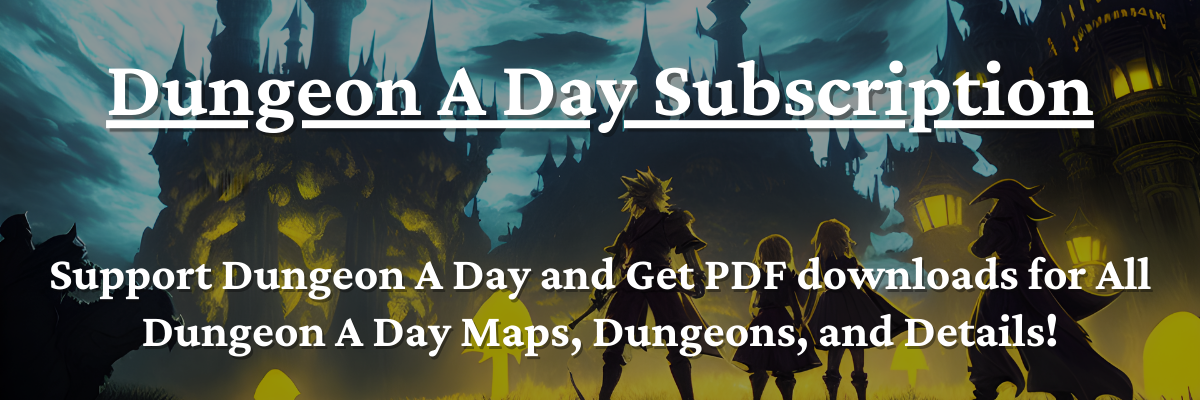Dungeon A Day - Crypt of the Plaguebringers - Day 24
For months, heroes from across the land have gone missing, slave ships have ransacked coastal villages, and even members of the fabled dragon knights have been slain. Now, you find, that all is related.
It took weeks to subdue a single "plague cultist," and he didn't give up without a fight. Though he wouldn't talk, you found clues in his traveling bag that led you here, to depths beneath a forgotten city of Eboncrest.
Unfortunately, it seems the Crypt of the Plaguebringers is already nearing its goal, however, and the cultists' powerful spell is about to be unleashed upon the lands of Altius, if no one can stop them.
Day 24 - Green Dragon Statue
Use the Dungeon A Day Adaptation Page to Modify this Content to fit Your Favorite TTRPG
Room Description (Read the Following Text to Your Players)
(If players overturned the cauldron in dungeon room 18, this statue "Activates" - see below. Otherwise, the statue is simply a statue).
The hallway from dungeon room 23 takes you to an enormous statue that features a green dragon, coiled upon a rock. This dragon is snake-like in appearance, with no arms, legs, or wings, yet the spines along its length, and the creature's head are unmistakably dragon in nature.
Room Challenges
- Activated Dragon "Statue": this Dragon "Statue" is alive... it is not a stone statue, but an actual creature, just lying dormant, currently. When players overturn the cauldron from dungeon room 18, the poisons contained therein awaken this creature. However, the concoction was not complete, so the dragon only awakens at part of its possible strength. When players enter this room, it attacks them with an ambush round, as the "statue" suddenly springs to life.
- Break in the Wall: the Crypt's walls are so ruined at the bottom right of this dungeon room that players may see through the collapsed wall to the overhang above. Being below, players can't see what's in there (if they haven't been, already), but it is dungeon room 22. Players may scale the 10ft hang to dungeon room 22 should they wish. Furthermore, if players either "Activate" the dragon statue and battle it (above), or if they cut off its head (below), then the four Plague Cultists from dungeon room 22, if they're alive, will immediately run from the barracks to this room/ jump from the overhang and attack the party.
- Green Dragon Statue: a successful Intelligence roll (Fate Roll Difficulty matches Avg. Party Level, -1) reveals that this dragon statue may indicate where new recruits to the Plague Cultist ranks are to go, once they arrive to the Crypt (given that the "barracks" is located nearby). The strong ocean smell in the air suggests that this area could well be how new recruits get here. A Double-Success Fate Roll also reveals that this Dragon Statue is also alive... that it is not a stone statue, but an actual creature, just lying dormant, currently (see "Activated Dragon Statue," above). Should characters cut off the head of this dragon, they will slay the beast before it may rouse from its death-like slumber. Slaying this dragon is another one of the keys to stopping the plot of the Plague Cultists.
Enemy Stats
Dragon "Statue": "Demi-Boss" enemy Difficulty (match Avg. Party Level). Option to use the "Assassin AI." Beginning with the first round of combat, and every 3rounds after, the dragon breathes poisonous gas as the pyromancer "Pyro Storm" spell, but that deals poison damage and also applies poison if it hits, as the assassin "Assassin's Poisons" ability. Once the dragon takes 3damage, it flies into the ceiling of this dungeon room, shattering the rock, and escaping to dungeon room 60. See the Dungeon A Day - Enemy Stats and AI page for more details.
(Plague Cultists): if present - "Weak" enemy Difficulty (match Avg. Party Level). Option to use the "Baseline AI." See the
Dungeon A Day - Enemy Stats and AI page for more details.
Dungeon A Day
Visit the Dungeon A Day - Crypt of the Plaguebringers Overview Page to see all Dungeon Rooms in this series.
Visit the Dungeon A Day main Page to see all of the Eternity TTRPG dungeons!
Dice, Dungeons, Games & More - Eternity TTRPG
Share This Article

Author - Jacob Tegtman
Dear reader, I hope you enjoyed this article. Tabletop gaming has been a passion of mine since I was 6 years old. I've played just about every game from Dungeons and Dragons to video games like Final Fantasy. These games have inspired me, made me laugh, made me cry, and brought me endless hours of enjoyment.
I started Eternity TTRPG - and the indie tabletop game that goes along with it (Eternity Shop) - to share my love of gaming with others. I believe that in our technology-driven age, tabletop games help bring a sense of magic and community back into our world.
If you love the site, please share it with others! I have lots of gaming-related material for you to peruse and use in your own gaming sessions. If you have any questions about the site or want to contribute, just send me a message using the "Contact" page, which you can find in the site's footer.












